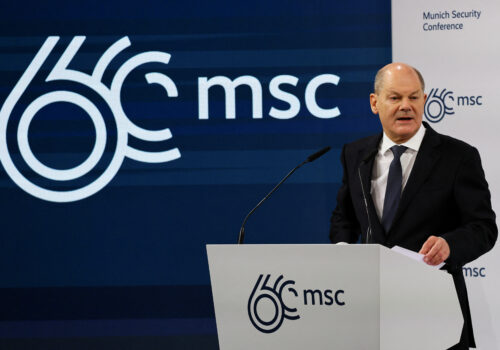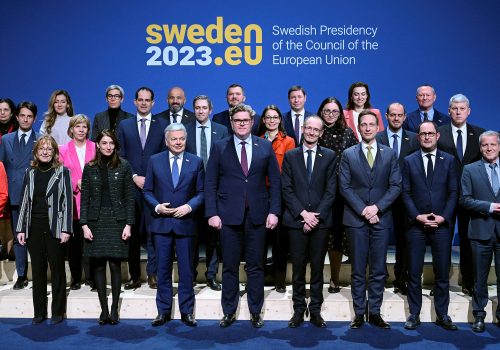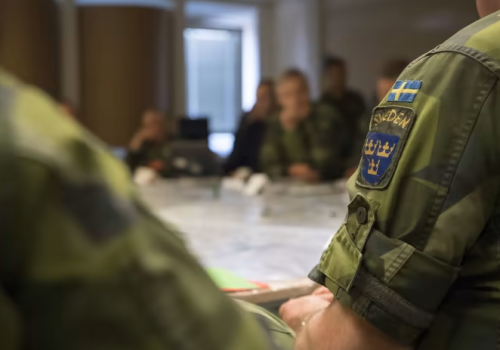It’s Swe-done: What’s next for NATO now that Hungary has approved Sweden’s bid to join
Table for thirty-two. On Monday, Hungary’s parliament ratified Sweden’s accession to NATO, the final approval needed to welcome Sweden into the Alliance. Hungary’s vote comes more than six hundred days after Sweden, in response to Russia’s full-scale invasion of Ukraine, decided to end its long-standing nonalignment and apply to join the Alliance. There are technical details to complete: Hungarian Prime Minister Viktor Orbán must sign the ratification, which he has said he will do, and Hungary must deposit its ratification instruments with the US government. But bigger questions also remain: What has this process revealed about NATO’s open-door policy? How will Sweden’s military alter the Alliance’s position in the High North? And how might Russia respond? Below, Atlantic Council experts take stock(holm) of the situation.
Click to jump to an expert analysis:
Christopher Skaluba: A day to celebrate NATO’s imperfect democratic decision-making
Dan Fried: Sweden’s entry is a setback for Russia and a rejoinder to NATO skeptics
Ian Brzezinski: Sweden’s membership was well worth the effort
Joslyn Brodfuehrer: Sweden accession deepens NATO’s bench—and bolsters its stockpiles
A day to celebrate NATO’s imperfect democratic decision-making
It has been a long-time coming, but Sweden has finally cleared the last hurdles to its NATO membership as the Turkish and Hungarian parliaments have ratified Sweden’s accession over the last few weeks. It is a shame it has taken this long—Sweden and Finland jointly applied for membership in May 2022—but the delay is a circumstance worth reflecting upon with some important insights into how NATO works.
In an alliance of thirty-two members, it is inevitable that allies will clash on certain issues. Bilateral disagreements between Stockholm and Ankara and Stockholm and Budapest contributed to the delay in getting Sweden’s membership across the line, showing the importance of constructive bilateral relations for keeping large institutions healthy. It may seem counterintuitive, but bilateral relations become more rather than less important once inside NATO, a point I have consistently made to Finnish and Swedish colleagues.
Of course, another aspect to the delay was the unseemly relationships between Turkish President Recep Tayyip Erdoğan and Orbán with Russian President Vladamir Putin. Putin’s disdain for NATO is well understood and that he could use his influence with NATO heads of state to delay Swedish membership is distressing. The delay also provided the Kremlin with the time and opportunity to undermine Sweden’s efforts to overcome Turkish and Hungarian objections through targeted disinformation campaigns.
Nevertheless, all the obstacles that Putin and others threw in the way of Sweden’s membership are now cleared, and NATO has grown again. Here is perhaps the most important lesson of all. Democratic institutions—like democracy itself—are messy. They require deliberation, debate, and horse-trading, which can be slow and painstaking. But when a decision is finally reached, it is likely to be more impactful for having worked through ahead of time any glitches that could undermine its effectiveness. Rather than wring my hands over the delay in Swedish membership, I choose to celebrate the fact of NATO’s imperfect democratic decision-making. A vengeful and determined Putin could slow but not ultimately undermine NATO’s intrinsic resilience—a fact that should be celebrated every bit as much as Sweden finally taking its formal seat at the NATO table.
—Christopher Skaluba leads the Transatlantic Security Initiative in the Atlantic Council’s Scowcroft Center for Strategy and Security.
Sweden is set for an impressive start in NATO, but its ratification delays are a cautionary tale
There it was at last, the Hungarian parliament’s ratification of Sweden’s NATO application. Now that the last country has ratified Sweden’s accession, only procedural details remain, and they’re so minor that NATO officials expect to hoist the Swedish flag at NATO’s headquarters this week.
But it’s no secret that Sweden’s accession was far more complicated than expected. Indeed, Sweden’s application was so straightforward that its accession should have encountered no delays. That’s why Sweden’s NATO accession matters far beyond Sweden and NATO: it’s a cautionary tale for all Western governments. The Swedish NATO bid fell victim to geopolitical wrangling and grandstanding that had little to do with Sweden, and with goodwill fraying among Western nations and their partners, other foreign and security initiatives are likely to encounter similar obstacles.
Now, though, Sweden will finally see its flag hoisted at Boulevard Leopold III, and it will be off to a rapid and impressive start as a member of the Alliance. The Swedish government has already announced that it will allocate a battalion to the brigade NATO is establishing in Latvia. Some existing members contribute much less than that to NATO’s Enhanced Forward Presence; indeed, some contribute nothing at all. The strong Swedish Air Force will strengthen the Alliance, and in the Baltic Sea the Swedish Navy will be crucial in the protection against infrastructure saboteurs and Russian Navy vessels. Indeed, as of this week, many within the Alliance are likely to ask what NATO ever did without Sweden.
—Elisabeth Braw is a senior fellow with the Atlantic Council’s Transatlantic Security Initiative in the Scowcroft Center for Strategy and Security.
Sweden’s entry is a setback for Russia and a rejoinder to NATO skeptics
The (delayed) vote of the Hungarian parliament removes the last obstacle to Sweden’s accession to NATO as its thirty-second member. What does that mean for Sweden, for NATO, for Russia, and for the United States?
For Sweden, NATO membership provides deepened security to deal with a deepened Russian threat. Gone is the Swedish (and Finnish) option of formal, though pro-Western, neutrality maintained during and after the end of the Cold War. NATO membership went from being an exotic option with little support to an urgent priority in just two years, triggered by Russia’s full-scale invasion of Ukraine.
For NATO, Sweden’s accession brings additional military capability and geographic advantage that will assist in defending the Baltic states and limiting Russian use of the Baltic Sea to intimidate or attack NATO members.
For Russia, Sweden’s (and Finland’s) accession is a strategic setback. Russia has blamed NATO enlargement for a host of ills and many of Putin’s Western apologists blame the threat of NATO enlargement to Ukraine for setting off Russia’s invasion. In fact, movement toward NATO enlargement to Ukraine was nonexistent in both 2014 and 2022, Russia’s first and then full-scale invasion of Ukraine. But the 2022 invasion triggered actual NATO enlargement elsewhere that otherwise would not have taken place.
For the United States, Sweden’s accession to NATO vindicates the US investment in the Alliance for the past seventy-five years: For nations under threat, NATO is the place to be. Sweden has military capacity and is increasing it (this year, it will meet the threshold of spending 2 percent of its gross domestic product on defense) to the benefit of the United States and Europe alike, showing NATO skeptics, including former US President Donald Trump, that it can and will pull its weight.
—Daniel Fried is the Weiser Family distinguished fellow at the Atlantic Council and a former US assistant secretary of state for Europe.
Sweden’s membership was well worth the effort
Today’s ratification by Hungary’s parliament of Sweden’s NATO accession protocol is the last step before the Nordic nation becomes a member of the North Atlantic Alliance. The rest is a formality, and Sweden’s seat at the table as NATO’s thirty-second member will be one of the distinctive features of the Alliance’s summit in Washington, DC, this July.
Sweden and Finland applied for NATO membership on May 18, 2022 following Russia’s brutal full-scale invasion of Ukraine. That was a historic step for Sweden, ending a policy of neutrality that dates back to before the two world wars. Finland became a full NATO member in April 2023, but Sweden’s route was blocked by Turkey and Hungary for a year and ten months, a fact that underscores the challenges that come with NATO’s principle of consensus. Nonetheless, this was fast compared to previous applications. Poland’s membership took some seven years of effort before NATO welcomed it to the table in 1999.
It is well worth the effort. Sweden’s membership will strengthen the Alliance. The nation brings to the Alliance’s force structure a small but capable military force. Its some fifteen thousand men and women on active duty operate nearly one hundred multi-role Gripen jets and a navy featuring advanced conventional submarines. This is backed by a highly respected intelligence service and a technologically advanced defense industry. Moreover, Sweden brings to NATO decision making an acute, historically rooted understanding and concern about Russian aggression and an unquestioned commitment to transatlanticism.
—Ian Brzezinski is a resident senior fellow with the Scowcroft Center for Strategy and Security and is a member of the Atlantic Council’s Strategic Advisors Group.
Sweden accession deepens NATO’s bench—and bolsters its stockpiles
Sweden’s long-anticipated accession means that the NATO’s bench is now thirty-two allies deep—and this already integrated, soon-to-be ally is sure to feature in the starting lineup. Boasting the longest Baltic coastline of any country in Europe, Sweden will in effect turn the Baltic Sea into a “NATO lake” by bringing enhanced strategic and operational coherence to one of the Alliance’s most vulnerable regions. Stockholm also brings to NATO its formidable military capabilities, ranging from its sizable fleet of fighter jets to its cyber-defense force, as well as its keen understanding of Russia, the most acute threat knocking at NATO’s door.
Importantly, NATO’s newest ally will infuse industrial and innovation capacity the Alliance so desperately needs amid continued war in Europe. Sweden is projected to meet NATO’s 2 percent defense spending benchmark in 2024; it has a robust ecosystem of startups and innovation networks; and the country’s export-oriented defense industry is home to leading companies that manufacture cutting-edge equipment and command-and-control capabilities. For allies confronted with the need to sustain support for Ukraine and replenish limping stockpiles, greater access to Sweden’s robust defense industry will fill critical gaps that help the Alliance meet production demands and accelerate the development of the emerging technologies that will be necessary for allies to maintain their edge on the multi-domain battlefields of the future.
Sweden’s big step forward comes on the heels of Russian opposition leader Alexei Navalny’s death and at a time when the Russian threat is more acute than ever. But this new development stands as an important reminder that Putin’s full-scale invasion of Ukraine failed. Putin has so far been unsuccessful in breaking the resolve of brave Ukrainians and his actions have resulted in a NATO that is larger, more united, and better equipped than before. NATO remains the team of choice—Russia is watching from the stands.
—Joslyn Brodfuehrer is an assistant director with the Transatlantic Security Initiative at the Atlantic Council’s Scowcroft Center for Strategy and Security.
Further reading
Wed, Feb 21, 2024
What I heard in Munich: Europe gets a brutal awakening
New Atlanticist By Anna Wieslander
Fear loomed that next year, Europe would be squeezed between a fascist Russia and an undependable United States—a Europe that would be pretty much on its own.
Mon, Jan 30, 2023
Sweden has a chance to transform European security—even before it officially joins NATO
New Atlanticist By Franklin D. Kramer
Sweden can wield the agenda-setting powers of its presidency to push a EU security and defense budget directed toward three crucial aims: mobility, sustainment, and critical infrastructure protection.
Fri, Dec 22, 2023
Navigating Sweden’s NATO membership: Insights for political and operational adaptation
Issue Brief By Viltaute Zarembaite, Christopher Skaluba, Ann Marie Dailey
Sweden is on the cusp of joining Finland as NATO's newest members, bridging a crucial gap in the region's security architecture and creating new opportunities for closer security cooperation. Once Sweden is in NATO, the Baltic Sea will be a geographically coherent strategic space—or, in more casual parlance, a "NATO lake."
Image: General view of the Hungarian parliament during the vote on the ratification of Sweden's NATO membership.


